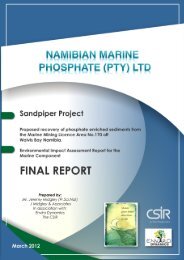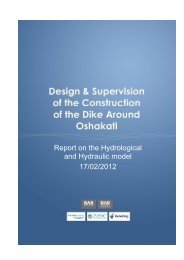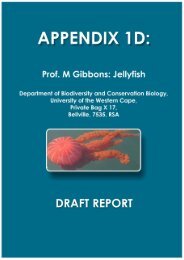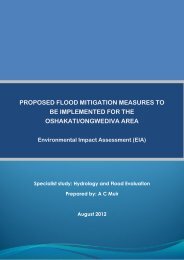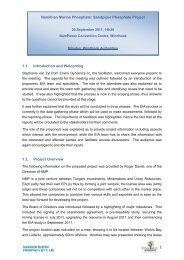Fisheries - Enviro Dynamics Namibia
Fisheries - Enviro Dynamics Namibia
Fisheries - Enviro Dynamics Namibia
Create successful ePaper yourself
Turn your PDF publications into a flip-book with our unique Google optimized e-Paper software.
F I S H E R I E S , M A M M A L S A N D S E A B I R D S S P E C I A L I S T S T U D Y<br />
8.5 IMPACT 5: IMPACT ON SEABIRDS AND MARINE MAMMALS<br />
The <strong>Namibia</strong>n coast supports large populations of seabirds (refer to Para. 4.1). The published<br />
literature (Cooper 1981, Wiliams and Cooper 1983, Cooper 1985, Berruti 1989, BirdLife<br />
International 2004, Hockey et al. 2005, Crawford et al. 2007, Kemper et al. 2007, Kemper 2007,<br />
Petersen et al. 2007, Pichegru et al. 2007, Ludynia et al. 2011, Sinclair et al. 2011). Numerous<br />
coastal seabirds are expected to be found in or near the MLA (refer to Para. 4.1). Also, Kemper<br />
(response to this EIA) suggests that using data logger technology several species of non-breeding<br />
seabirds are likely to forage well offshore. These include the species identified in Para. 4.1<br />
(African Penguin and Cape Gannet). These species are therefore likely to be found in and around<br />
the MLA. There is also a low likelihood that Bank Comorants and seasonal pelagic species<br />
(albatrosses and shearwaters) may be found occasionally in the MLA. In addition these species<br />
are likely to be impacted by the lights of the dredging operation (Ryan 1991).<br />
The <strong>Namibia</strong>n marine mammal fauna is considered a marginal component of the broad southern<br />
Atlantic marine mammal community and includes three species of pinnepeds (seals) and roughly<br />
40 species of cetaceans (whales and dolphin) (Griffin 1998). There has been a northerly shift<br />
(away from MLA in the south) in breeding seal populations in the last decade, which is thought to<br />
be linked to shifts in the geographical distribution of prey (Kirkman et al. 2007).<br />
Baleen whales are thought to be primarily seasonal visitors to the <strong>Namibia</strong>n coast (Para. 4.3<br />
refers) although some species may support resident populations (Griffin 1998). Today most<br />
species which were once exploited remain very rare (Bianchi et al. 1999) and whales are now fully<br />
protected by <strong>Namibia</strong>n legislation. While the <strong>Namibia</strong>n breeding population of southern right<br />
whales Eubalaena australis is thought to have been eradicated by over exploitation (Roux et al.<br />
2001 in Currie and Grobler, 2007), the historical breeding range included Walvis Bay, Conception<br />
Bay, Spencer Bay, Lüderitz Bay, Elizabeth Bay and the Sperrgebiet coast. Since 1996 calves have<br />
been sighted between Conception Bay and the Orange River, indicating the presence of a<br />
breeding population. Mother and calf pairs being recorded within 1 nautical mile of the shore in<br />
the shelter of Conception Bay and six locations to the south (Currie and Grobler 2007).<br />
Other baleen whales (Para 4.3 refers) that occur along the <strong>Namibia</strong>n coast include, but are not<br />
limited to, pygmy right whales Caperea marginata, fin whale Balanoptera physalus, minke whale<br />
Balaenoptera acutorostrata, humpback whale Megaptera novaeangliae (Bianchi et al. 1999). All<br />
of these species are widely distributed on a global scale but detailed records of the distribution<br />
and habitat use of these animals along the <strong>Namibia</strong>n coast are not available. Toothed whales<br />
known from <strong>Namibia</strong> include sperm whale Physeter catodon, killer whales Orcinus orca and the<br />
longfinned pilot whale Globicephala melas (Bianchi et al. 1999). All of these species have wide<br />
global distributions and thought to be occasional visitors to <strong>Namibia</strong>n coastal waters. A number<br />
of dolphin species, most notably the dusky dolphin Lagenorhynchus obscurus, bottlenose dolphin<br />
Tursiops truncatus and Heavisides dolphin Cephalorhynchus heavisidii are year round residents<br />
along the <strong>Namibia</strong>n coast (Griffin, 1998).<br />
The MLA is located in a critical area offshore – that is mid-shelf along the 200 m bathycontour. Its<br />
location is therefore close enough to the shore line to expect coastal and oceanic sea birds as well<br />
as the large migrating whales and the more localised distributions of the smaller mammals (such<br />
a common dolphins and pilot whales). It is therefore assumed that there is a likelihood that<br />
Final Report<br />
<strong>Namibia</strong>n Marine Phosphate (Pty) Ltd.<br />
Page 73



